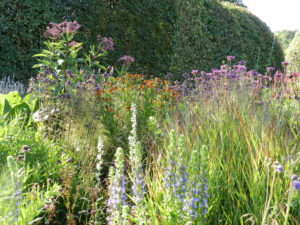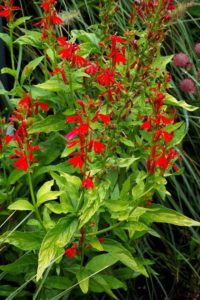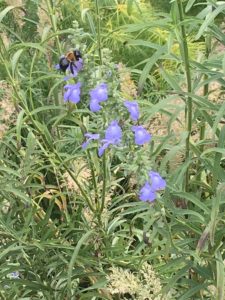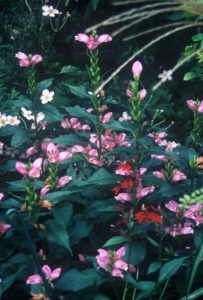
Lobelia siphilitica, Eupatorium, Monarda, Helenium, Panicum red in Piet Oudolf’s personal garden
Our landscapes have been graced by the beauty of lobelias for many years. There are both annual and perennial lobelias, native in many parts of the world, but I will discuss only the perennial ones that are useful in bringing late summer color to our gardens.

Lobelia cardinalis closeup; Franklin Park Conservatory

Lobelia cardinalis ‘Golden Torch’-Learn2Grow
The best known of these is Lobelia cardinalis (Cardinal Flower) which is native to a large part of the United States and hardy from zones 5 to 7. Its bright red spike of tubular flowers, held well above the dark green, irregularly toothed foliage, can be seen from great distances in early August. I will never forget spying a stand of it across a rather large lake while the rest of the flora appeared as a green mass. This lobelia grows two to four feet tall and only two feet in diameter, prefers moist soil in a site with morning sun or partial shade, and will disappear within a year or two if it is subjected to dry conditions. Frequently found in nature on stream banks, this is an excellent candidate for plantings near designs of water features. The combination of the color red and the tubular aspect of the flowers provide a strong attraction to hummingbirds and butterflies. The cultivar ‘Golden Torch’ has yellow foliage and is definitely an eye-catcher but is no more long-lived than the species.

Lobelia siphilitica with bee;The High Line (NYC)
The other native American lobelia is Lobelia siphilitica (Big Blue Lobelia) that is hardy from zones 4 to 8. As its name implies, the thick spike of tubular florets is medium blue and is surrounded by leafy bracts. Lobelia siphilitica blooms about three weeks later than Lobelia cardinalis and is not quite as tall, usually only growing three feet tall but the height of both lobelias is influenced by the amounts of moisture and shade in which they grow.

Lobelia gerardii ‘Vedrariensis’ – birddatabase.org
My favorite lobelia is Lobelia x gerardii ‘Vedrariensis’, beloved for its iridescent purple spikes. This lobelia is a bit taller than the ones mentioned above, growing three to five feet. It stretches in partial shade and leans as well so I prefer to grow it in full sun with abundant moisture. Hardy from zones 5 to 7, this lobelia blooms in August and September. Neither this lobelia nor Lobelia siphilitica seem to be as picky about their site as Lobelia cardinalis.
There are also several Lobelia hybrids now, ranging in color from shades of pink and purple to some red ones with dark foliage. The Fan series is composed of plants that are somewhat shorter than any of the species, growing only two and a half feet high The hardiness of the dark foliaged lobelias is somewhat in question for those of us in zones 5 and 6 so it would be best to site them in your warmest microclimates. I greatly appreciate the hybrid Lobelia ‘Ruby Slippers’ because the ruby red color of the flowers blends well and brings excitement to an otherwise bland garden of pastel pinks and blues.
All lobelias can be propagated by seed or division and seem to enjoy greater longevity if divided every two or three years.

Chelone lyonii ‘Hot Lips’ and Lobelia ‘Ruby Slippers’ in my garden
Lobelia is a great addition to the palette of late summer and early autumn perennials. I have used Lobelia ‘Ruby Slippers’ and Chelone lyonii ‘Hot Lips’ (medium pink) next to each other because they bloom at the same time with Aster ‘September Ruby’ and Aster ‘Hella Lacy’ (dark purple) nearby. The asters start to bloom just as the Lobelia and Chelone are finishing their bloom times although both have interesting seed heads to complement the composition.
I suggest visiting growers or garden centers so that you can see the variety of colors available in this wonderful genus.


0 Comments